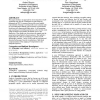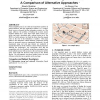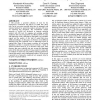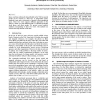132
click to vote
GIS
2003
ACM
15 years 3 months ago
2003
ACM
This paper introduces an approach for closer integration of selforganizing maps into the visualization of spatio-temporal phenomena in GIS. It is proposed to provide a more explic...
132
click to vote
GIS
2003
ACM
15 years 3 months ago
2003
ACM
Nearest neighbor query is one of the most important operations in spatial databases and their application domains, e.g., locationbased services, advanced traveler information syst...
118
click to vote
GIS
2003
ACM
15 years 3 months ago
2003
ACM
A GIS provides a powerful collection of tools for the management, visualization and analysis of spatial data. These tools can be even more powerful when they are integrated with s...
110
click to vote
GIS
2003
ACM
15 years 3 months ago
2003
ACM
Location-Based Services (LBSs) utilize information about users' locations through location-aware mobile devices to provide services, such as nearest features of interest, the...
111
click to vote
GIS
2003
ACM
15 years 3 months ago
2003
ACM
With wireless communications and geo-positioning being widely available, it becomes possible to offer new e-services that provide mobile users with information about other mobile ...
113
click to vote
GIS
2003
ACM
15 years 3 months ago
2003
ACM
Moving object databases store and process data for objects that change location frequently. Materialized views maintained over time must be updated to reflect changes due to the m...
105
click to vote
GIS
2003
ACM
15 years 3 months ago
2003
ACM
We present a technique for creating a digital elevation model (DEM) from grid-based contour data. The method computes new, intermediate contours in between existing isolines. Thes...
108
click to vote
GIS
2009
ACM
2009
ACM
Web 2.0 Geospatial Visual Analytics for Improved Urban Flooding Situational Awareness and Assessment
15 years 3 months ago
Situational awareness of urban flooding during storm events is important for disaster and emergency management. However, no general purpose tools yet exist for rendering rainfall ...
121
click to vote
GIS
2009
ACM
15 years 3 months ago
2009
ACM
The k-anonymity technique is widely used to provide location privacy protection for accessing location-based services (LBS), i.e., the exact location of a query initiator is cloak...
110
click to vote
GIS
2009
ACM
15 years 3 months ago
2009
ACM
Space- and time-referenced data published on the Web by general people can be viewed in a dual way: as independent spatiotemporal events and as trajectories of people in the geogr...




